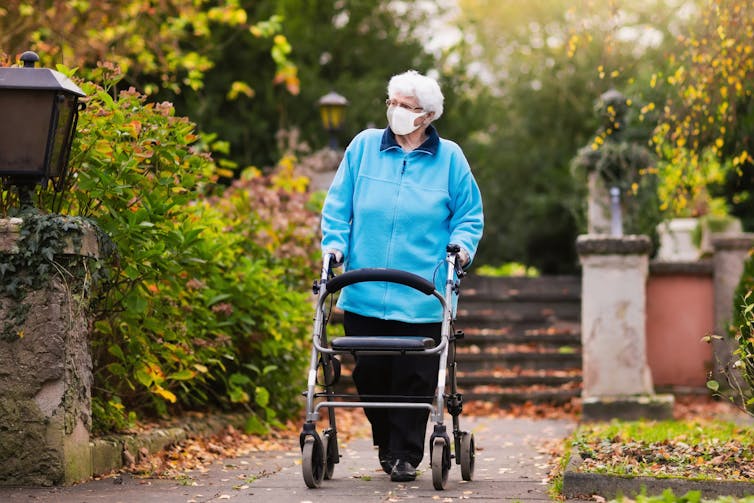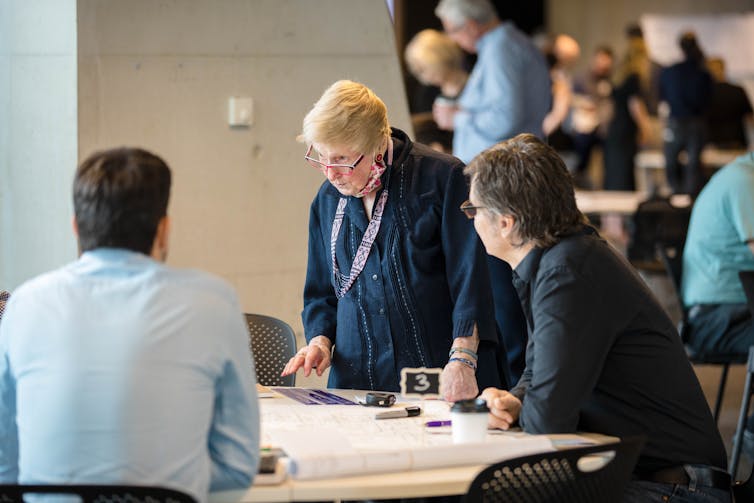The stark difference between an aged care “home” and a real home has been laid bare by the COVID pandemic.
Residential aged care buildings are often institutionally designed, even if they have the appearance of a hotel. Think long corridors, vast dining rooms, nursing stations and bland corporate furnishings.
These design choices support a model of care underpinned by cost efficiencies rather than real people’s rhythms of daily life.
So, how can we make aged care facilities feel more like home, while keeping them pandemic-safe?

More like a ‘container’ than a home
Residential aged care facilities are deeply restrictive environments; some have compared them to prisons.
During the pandemic, things were made worse as residents were denied the right to leave their rooms or have visitors. For many residents, it must feel like prevention is worse than the disease, as physical and psychological health declines markedly in imposed isolation.
Hotel-like residential aged care rooms are no place for long periods without the company of others. Some residential aged care centres may look like luxury resorts, but residents are still incarcerated.
Often residential aged care centres are more like a “container” than a home; a container that dispenses shelter, food and medical care.
So, what might we do differently in the post-pandemic era?
To try to answer this question, we held a collaborative design workshop involving architects and stakeholders, including managers from the residential aged care sector. We sought to visualise design ideas using three existing not-for-profit residential aged care sites as testing grounds.
We asked the group to ponder: what makes a home “home-like”? And how does that differ from the environment at an aged care centre?

Three key ideas emerged, all of which could help a facility feel more like a home while also reducing the impact of future pandemics.
1. Make aged care facilities indistinguishable from their surrounding neighbourhoods
Residential aged care facilities are often walled and gated enclaves set apart from the surrounding community. Residents are secluded in wards and aren’t part of the natural ebb and flow of the community.
A home, on the other hand, is usually directly connected to the outside world.
Embedding indistinguishable residential aged care households in the heart of an active community would add to the broader social and physical fabric and build support networks.
In practice, this could mean opting for smaller buildings that look similar to surrounding buildings, rather than large and imposing structures.
It could mean offering a wide range of housing choices, from houses to apartments, and softening wall and gate barriers so residents easily connect with everyday community life.

2. Ageless communities and support networks without moving house
Our group took inspiration from the urban design concept known as the “five-minute community”, where everything is a short walk away.
We imagined designs that allow for self-sufficient small households of up to eight residents, with different generations also located in the same street. “Ageless” communities like this allow for different generations to interact (either incidentally or deliberately).
Residents could easily adjust the level of support needed (up and down) over time, while staying at home. Intensive rehabilitation could be delivered in the home or nearby. For example, people who have had a fall could access rehabilitation and restorative services in the local area.
We also looked for ways to take advantage of existing spaces in the community rather than constructing new aged care facilities that are set apart.

3. Designed-in respiratory infection prevention measures
Big isn’t always better.
Small home models deliver an antidote to isolation and the spread of airborne respiratory infection.
Smaller stand-alone buildings are less reliant on centralised air-circulation systems and can deliver strategies to reduce infection transmission by ensuring all rooms have access to fresh air and natural ventilation.
Smaller households can quarantine without the need to lock down a large facility.

Community participation and engagement built into the design
Entrenched approaches to residential aged care design assumes residents can do little independently. An unquestioning focus on inabilities further disempowers: “care” is done “to” or “for” a resident in a “facility”.
For example, residential aged care meals are generally pre-prepared and eaten in a large-scale room with many others (including strangers).
At home, by contrast, people decide what, when and where to eat. The small home approach in five-minute communities would allow, for instance, people of different generations to cook together or for a younger person to cook for an older person while also learning new skills.
Designs that acknowledge older people have knowledge and skills to contribute allow for such interactions to occur.
When workshop participants challenged their own expectations, they envisioned design concepts emphasising living, not just existing, until end of life.
The residential aged care crisis is escalating, and structural and cultural change is desperately needed.
It’s time to rethink these physical environments with peoples’ fundamental human needs at the heart of design.![]()
Rosemary Kennedy, Adjunct Professor of Architecture and Urban Design, Queensland University of Technology and Laurie Buys, Honorary Professor, The University of Queensland
This article is republished from The Conversation under a Creative Commons license. Read the original article.











What a lot of rubbish authored and printed by people that have no bloody idea.
1. facilities are secure for the safety of residents. The suggestion here is unrealistic and unsustainable.
2. Residents don’t age evenly, to have a forever home doesn’t appreciate the care needs of various residents. Some age gracefully and others become aggressive, incontinent, abusive etc and others don’t. Would you want to be living in an eight-bedroom house and find your bed with faeces on your pillow? That’s reality!
3. Loads of facilities have evaporative cooling that replaces the air in the building every minute. In a small facility of eight, one might be affected but the other seven aren’t… will they be happy about that? No.
It’s naive and ignorant to believe residents in a small group could participate in housework, cooking etc any better than in a 100-bed facility. People go to residential care because they CANT undertake those chores at home. This is not a new idea, “cluster” homes were popular 20 years ago, suggested with the same ignorance and inexperience of the suggestion here.
I have carefully read the post and the reply and find myself wishing for a design outcome that meets the needs of aged people who need additional support in a homely environment, and of staff who have often been trained and worked in hotel-type or institutional settings that are explicit in their intention to contain and restrict movement, and where fundamental services are ordered to meet the demands of changing shifts and managing tasks efficiently. My lived experience includes caring for my mother living with Alzheimer’s until a crisis pre-empted her being admitted to an aged care facility. She was unable to adapt to her new, unfamiliar living conditions and her mental health deteriorated very quickly. She failed to recognise family members, including her husband who visited her daily for the next few years, and although her physical needs were met, we watched her sense of self disintegrate completely.
I have visited many aged care facilities and believe that new models of accommodation need to be designed to reflect the shift in care to a more holistic model. Who could have believed that large institutions for the disabled could be replaced by supported living in community houses? I was one of many early advocates for de-institutionalisation in South Australia and have yet to hear anyone asking for the return of those forbidding buildings and restrictive practices.
Let’s work together and harvest the knowledge and experience of dedicated, innovative aged care workers, consumers, families and bodies like Ariia, harvest the research, and trial some models.